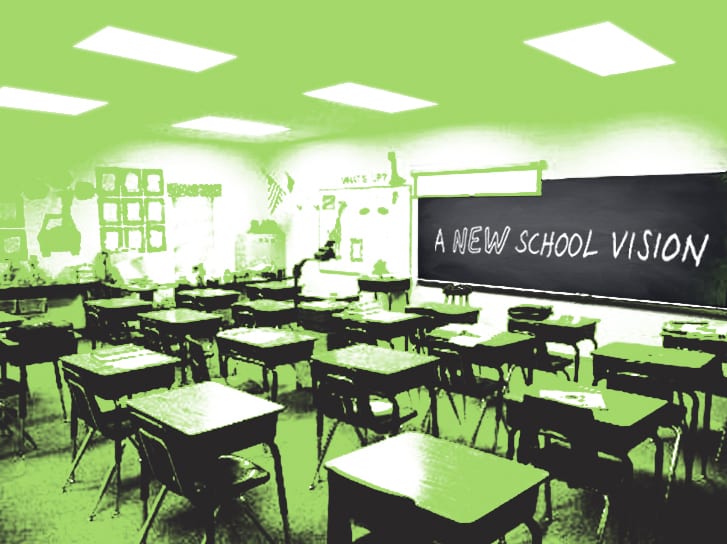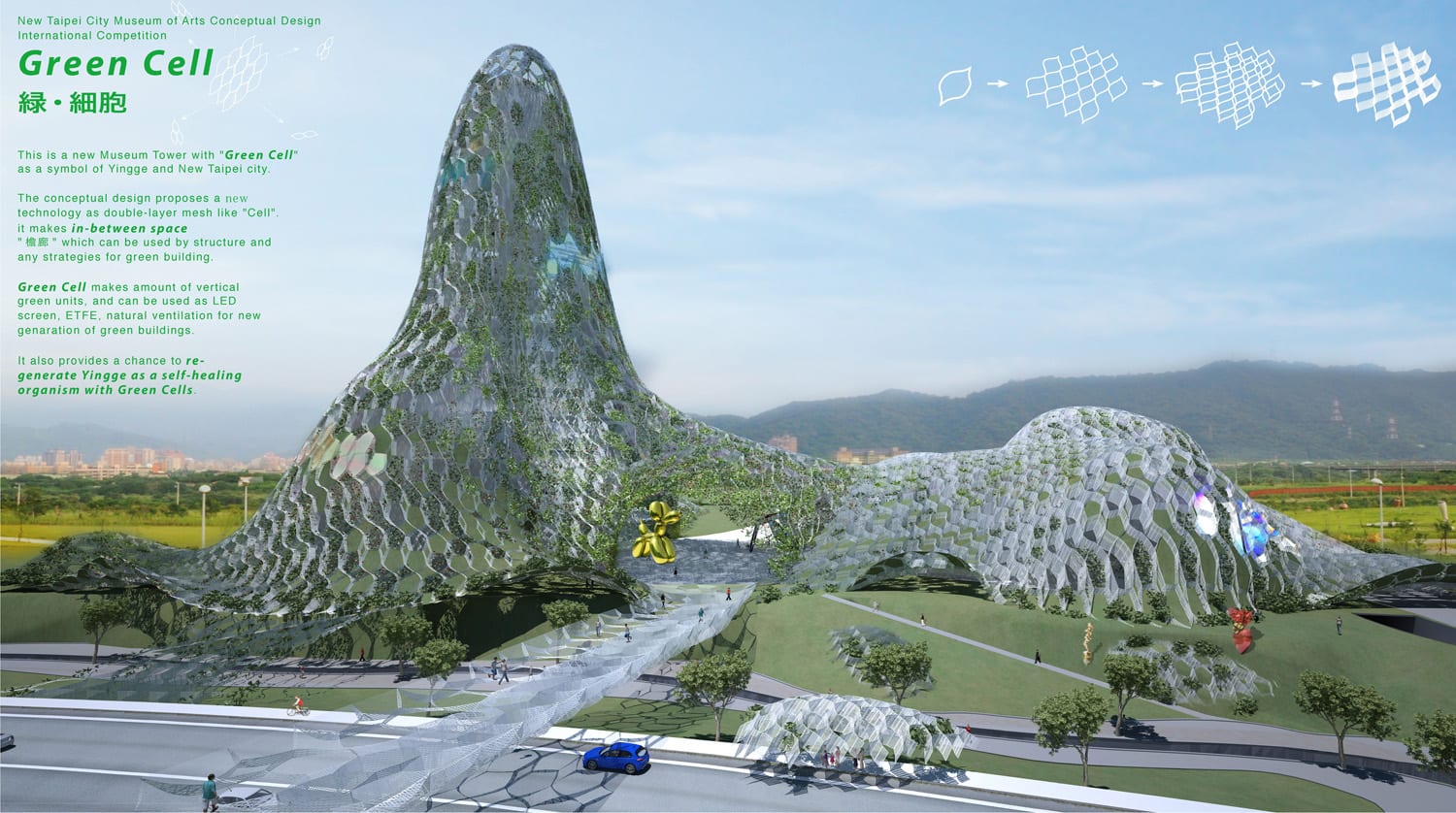A Dramatic Curtain: The Taiwan Tower International Competition
The Taiwan Tower International Competition
by Stanley Collyer

The sponsors of the Taiwan Tower Competition have managed to come up with a departure from a generic solution to an observation tower. Instead of settling on the ubiquitous column with a sphere on top, they picked a green solution by the Japanese architect, Sou Fujimoto, which simultaneously conveys the appearance of a giant theater curtain, ready to reveal the unfolding of an interesting drama. Instead of illustrating the bare bones of a support system, the structure is shrouded in mystery, and, aside from its character as a model of sustainability, it should draw crowds of curiosity seekers for decades to come.
Bringing Life to the Center: The Aberdeen City Garden Competition
The Aberdeen City Garden Competition
by Stanley Collyer

Aberdeen, Scotland has long been the beneficiary of the oil bonanza off its coast in the North Sea. But faced with declining oil revenues from this source, the community now finds itself at a crossroads: how do you reinvent yourself while a once dependable revenue stream is slowly disappearing? Urban issues logically came to the forefront, and the discussion concentrated on Aberdeen City Gardens, an underused park smack in the middle of the city. If this relatively dormant piece of real estate could be turned into a people place for the community and beyond, it might not only help to rejuvenate the city’s urban core, but provide it with an asset having a symbolic value well beyond that of a common green space.
Improving Education by Design: The 2011 Cleveland Design Competition
The 2011 Cleveland Design Competition
by Stanley Collyer

Can reducing class size and hiring more qualified teachers be the only answer to improving our educational system? Not according to the goals set forth by the organizers of the most recent 2011 Cleveland Design Competition. This open contest challenged architects to come up with new ideas, keeping pace with “the continuing advancements in pedagogy, curricula and organization models.” In other words, why shouldn’t equal attention be devoted to the “reinvention of learning environments.”
Seeking New Paradigms in Landscape Architecture: The Taichung Gateway Park Competition
Seeking New Paradigms in Landscape Architecture
The Taichung Gateway Park Competition
by Dan Madryga

Taichung is a city with grand ambitions. Taiwan’s third largest metropolis has been developing an impressive inventory of architecture and planning projects that envision the city as a new hub for design innovation and inspiration. And as in Taipei and Kaohsiung, open international design competitions are an important part of this process, attracting creative talent from around the globe and prompting compelling, forward-thinking designs. Taichung first garnered the attention of the global design community with 2010’s Taiwan Tower Competition, a forum that sought an iconic design for a landmark observation tower commemorating the centennial anniversary of the founding of Taiwan. The winning project, an eye-catching, garden-topped “21st Century Oasis” designed by Japanese architect Sou Fujimoto, is sure to become a major attraction for the city.
Museum as Sustainability Model: The Taipei City Museum of Art
The New Taipei City Museum of Art Design Competition
by Stanley Collyer

To arrive at a design for a new art museum in Taipei, the organizers decided to allow the participants more flexibility than usual in devising their planning concepts for the new institution. According to the design brief, “the planning and design guidelines in this program are for reference only. The designer must propose…new possibilities for modern art museums, define the exhibition method, and propose new space requirement, then proceed (in) the planning and design based on the new required spaces and design guidelines.”
Focusing on the Center: Fargo’s Urban-infill Design Competition
Fargo’s Urban-infill Design Competition
by Stanley Collyer

As the largest city in the U.S. state of North Dakota, Fargo can afford to speculate about a redesign of its downtown core. Considering the state of the U.S. economy, one might question the planning of such an ambitious venture. But, in contrast to the rest of the nation, North Dakota’s economy is experiencing boom-like symptoms, supported mainly by the energy and agricultural sectors. Until recently, most outsiders regarded Fargo as a sleepy, northern, small city. Now, with a metropolitan population of 200,000 and growing, the community can think bigger and better. Choosing a design competition for a downtown plan is an interesting move in this direction, even though this was only an ideas competition, and there is no guarantee any of the ideas from this event will be used.
The Gowanus Lowline Ideas Competition
The Gowanus Lowline Ideas Competition
by Dan Madryga

The landscape of waste: it is a common feature in any big city. Left in the wake of decentralized cities and waning industry, the neglected postindustrial terrain is an unavoidable blemish on the built environment. The desolate, ugly, contaminated vestiges of abandoned factories, overstuffed trash dumps and discontinued mills were pushed out of site and out of mind for decades as Americans sought refuge in suburbia. Yet as urban centers are gradually redeveloped and society expresses increased concern about environmental crises, these harmful, marginalized sites are becoming more difficult to ignore. On Brooklyn’s doorstep lies one such wastescape: the dormant and noxious Gowanus Canal. With help from the recent Gowanus Lowline ideas competition, locals are beginning to seriously contemplate a restorative future for this type of ailing urban environment.
Anticipating a Second Stage: The New Taipei City Museum of Art Design Competition
The New Taipei City Museum of Art Design Competition
by Stanley Collyer

To arrive at a design for a new art museum in Taipei, the organizers decided to allow the participants more flexibility than usual in devising their planning concepts for the new institution. According to the design brief, “the planning and design guidelines in this program are for reference only. The designer must propose…new possibilities for modern art museums, define the exhibition method, and propose new space requirement, then proceed (in) the planning and design based on the new required spaces and design guidelines.”
Bucolic Site as Museum Context: The Serlachius Museum Competition in Finland
Bucolic Site as Museum Context
The Serlachius Museum Competition in Finland
by William Morgan

In Finland, a land where architectural competitions are a way of life, a design contest for an addition to a small art museum drew the greatest number of entries in Finnish competition history.
That the Serlachius Museum in an out-of-the way city could attract 579 entrants from 41 countries may say something about the flat world economy. But it is more likely a measure of the attractiveness of the project, the reputation of the client, and the above-board way competitions are run in Finland.
A Community Icon Revisited: The Indianapolis Monument Circle Competition
The Indianapolis Monument Circle Competition
by Stanley Collyer
| The Arc de Triomphe, Brandenburg Gate and Red Square all share a common theme: they represent the spirit of their cities in the most visual urbanistic and symbolic sense. Always located in the central core, they may fulfill different functions—a traffic mode, gateway to the old city, or just central gathering place—but without such symbols, those cities would lose more than part of a historic past. Many small towns in the U.S. have their own courthouse squares; but few can rival Indianapolis’ Monument Circle. By virtue of its central downtown location, high visibility, and historic landmark status, it occupies a special chapter in the urban history of our nation. |
|


































